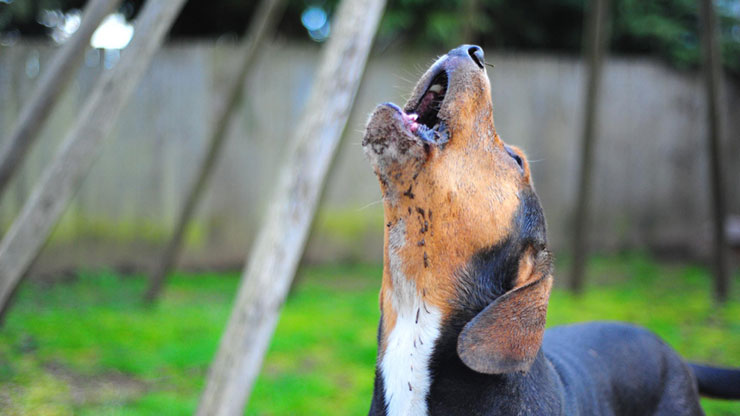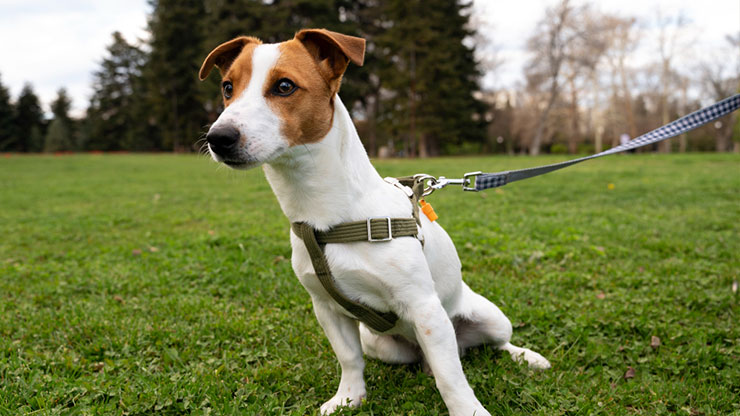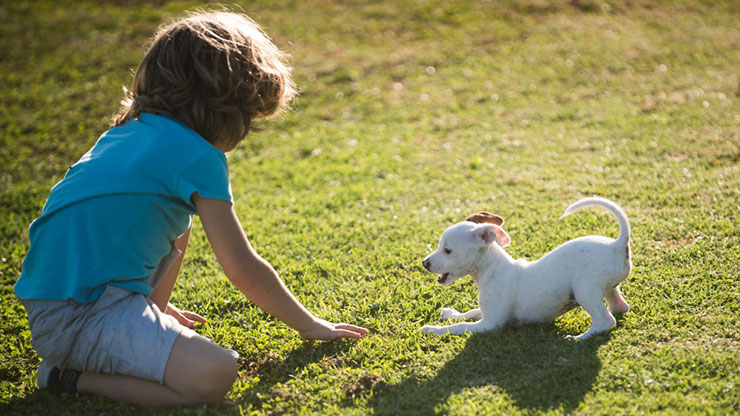
Training a Reactive Dog
There are some behaviors that dogs are well known for. They like to sniff, they like to run and play, and overall, they like to bark. All are normal behaviors for a dog while in context, but could these normal, natural behaviors become a problem? What if, say, a dog is barking more than normal? What if they seem to bark at, unexaggeratedly, everything or in persistent and over-the-top ways? What if they do more than just bark when faced with certain objects, people, situations, or other dogs? A larger issue could be at play here, meaning that a dog is reactive.
What Is Reactivity?
In the book, The Midnight Dog Walkers, Annie Phenix, CPDT-KA and canine behavior specialist, describes a reactive dog as one that “responds to normal events in his environment with a higher-than-normal level of intensity. Some of those overreactions include barking, whining, lunging, hypervigilance, panting, pacing, restlessness, and difficulty responding to his owner, even for well-known cues such as ‘sit.’ In short, a reactive dog is so stimulated by some person, situation, or other animals in its environment that it tunes out everything else, including its owner. They are not overly focused on any one thing in the environment. The reactive dog will be hyper-focused to the point he doesn't respond to his owner's cues or commands and may bark, lunge, pull, rush forward, or jump towards the triggering person, circumstance, or animal. This can ultimately lead to a number of dangerous situations.
These are just a few of the behaviors associated with reactivity in dogs, and if left unchecked, it tends to get worse as the dog grows older. Any dog can become reactive, thanks in part to a variety of factors that include environment, health condition, and early socialization, to name a few. However, some breeds, such as terriers and herding dogs, are statistically more likely to become reactive due to their observant and responsive nature, heightened prey drives, lower tolerance for other dogs, and higher levels of territoriality and possessiveness.

These dogs require a lot of exercise and mental stimulation to stay calm and properly adjusted. Without it, they will turn to other ways of expending their energy and meeting their needs, which can include the problematic reactive behaviors mentioned in this article. Often, reactive behaviors are a combination of a lack of proper early socialization combined with a need to expend pent-up energy and frustration stemming from a lack of environmental enrichment.
It is important to note that there is a difference between a dog being reactive and being aggressive. For reactive dogs, there is usually a specific trigger that causes them to be hyperaroused, but they do not wish to cause actual harm. However, their over-the-top and out-of-context reactions are inappropriate and can even be dangerous for the given situation. In many cases, their lunging, barking, and charging/rushing are viewed as threatening by other people and animals. Some dogs may respond defensively or aggressively, leading to problems such as dog bites or fighting. An aggressive dog is triggered by a stress or fear response and will respond accordingly to eliminate whatever triggers them, such as biting or attacking. This is a very basic definition of an aggressive dog; many factors can be in place in those situations as well. But the main point is that a reactive dog can look similar to aggression and escalate to aggression-like behaviors.
The Levels of Reactivity
An article by Cornell Richard P. Riney Canine Health Center cites that “A reactive dog is usually a fearful dog. Causes can be genetic, but they are more likely due to a lack of socialization, prior bad experiences, or a lack of training. Aggressive dogs show similar signs but are determined to cause harm and destruction. Any reactive dog can be pushed into aggression, which is why a reactive dog needs to be taken seriously.” Since dogs can grow to become reactive to certain things, a dog can exhibit different reactivity levels.
It is good to understand the different stages of reactivity and, therefore, know when it is best to intervene and confirm whether a dog is just barking or becoming reactive toward certain objects/situations. That way, an owner can better know what to look out for and when to be vigilant in order to communicate and help the dog efficiently.
- Level 1: When a dog is in a normal state of being. This is when they usually act calmly, take treats, and respond immediately to their owner.
- Level 2: The dog has become aware of the trigger. In this instance, they might become harder to tempt with a treat or a command. They will become alert, vigilant to the trigger, and focus on the trigger. This is the point at which the dog needs to be redirected away from the trigger and brought to a place where he can return to a level one state.
- Level 3: As their reactivity escalates, there is a lot of tension in their bodies, and they may pull on a leash if they are on one. At this point, they will not be responsive to their owners.
- Level 4: Finally, at the peak of their response, they may lunge and bark frantically, be only focused on the trigger and nothing else, pant, and not respond at all to their owner, treats, or anything else around them.
Breaking the Cycle
If a dog is having a severe negative reaction to things around them, there are ways that an owner can help the dog to better cope with triggers and reduce the level of fear that the dog may be experiencing. The idea behind this is to help the dog realize that they can respond differently to a trigger and don’t have to go into a fight or flight mode. Often, dogs don’t realize that there are other options for how they interact with the world around them - which is where training comes in! If an owner can help guide their dog to respond more calmly to situations or things, it can make a world of difference!
The first thing an owner can do is establish a good foundation for training by building their relationship with the dog. A solid foundation will build trust between the dog and the owner and will go a long way in motivating a dog to respond positively to training. In any training program, trust and engagement are necessary for positive results and changing behavior for the better. If a dog owner doesn't have their dog's trust and engagement, even in a relaxed, low-stress, low-trigger situation, they will certainly not get good results in a high-stress, highly triggering environment or situation. Positive reinforcement training for basic obedience commands, such as focus, sit, heel, down, and come, “should start in an area where the trigger isn't present and the dog is responsive to the owner. As the dog becomes better trained, more reliable, and fluent with their commands in these non-stimulating environments, they can slowly be introduced to a more stimulating environment by applying desensitization and habituation techniques."

Desensitization is one way that reactivity in dogs is addressed and treated. It is a process that decreases an emotional reaction to a trigger after repeated exposure to that trigger. In dog training and behavior modification, it is paired with positive reinforcement to train the dog to offer a more acceptable response to the trigger when the trigger is presented. Desensitization starts with low-intensity exposure to a trigger and then slowly increases the exposure with recurring sessions until there is no response to it.
Counterconditioning pairs something that created a negative response with something that gives a positive response. Using these two techniques together can introduce a dog to whatever is causing them to react, slowly make that introduction greater and greater, and then reward them when they do not react - therefore modifying their behaviors and showing them other preferred response options. This is the crux of reactive dog training efficacy and can make all the difference in a dog. Just using one method or the other is not enough! They are a positive way of helping dogs regulate their emotional response and their actions, which can be used for anything they may come across!
Continental Kennel Club has always recommended dog training with positive reinforcement. This can be done with a clicker and treats to reward the dog when they do an action that the owner wishes. It provides a positive experience for the dog and encourages them to want to perform a certain behavior again based on the cues they are given. This method builds trust and strengthens the dog's and the owner's bond. It is in high-tension moments that this foundation will come in handy the most.
Once a solid foundation of trust and training is formed with the dog, then the owner can proceed with slowly and gradually presenting the dog to the trigger. At first, from a non-triggering distance or in a very small, non-triggering amount. Then, as the dog continues to respond to the owner's cues and commands and remains calm, the owner can slowly move closer or increase the trigger. Positive reinforcement training for responding to the owner's cues and commands and remaining calm in the presence of triggers should be continued throughout the dog's life. This will ensure the dog retains their newly learned, more appropriate responses to triggering situations and scenarios. This will get the dog used to having the trigger around and better understand how to react to it - or, in a better case, NOT react to it.
Preventing Reactivity in Puppies
A good socialization regimen will prepare puppies to live in peace and harmony with other dogs, people, and animals. Puppies are generally open to new experiences and naturally eager explorers, so socialization provides an opportunity for a puppy to do just that. During the socialization window, puppies investigate and learn about their surroundings, new relationships, and their role within their environment. They need to encounter as many new sights, sounds, smells, situations, people, and other animals as possible from the moment they come home and continue into adulthood. And an owner needs to build a pup’s confidence by emphasizing the positives of these experiences. This will allow puppies to experience good things and come to expect good things from similar situations and new people in the future rather than experience anxiety from the unknown or fearfulness from negative experiences during these periods. They need to feel safe and successful in new situations to minimize future fear reactions, improve behavior, and reduce aggression.

Good socialization will give a puppy the best chance at a happy, fear-free life. So, what are some ways owners can provide good social encounters? They can ensure their dog is tolerant of children and has a positive meeting and home environment if other dogs live in the same household. While a puppy is young, an owner can stage an open house party and invite a few trusted neighbors, friends, and family to stop by one morning or afternoon. Encourage them to come and go for short visits. Include guests of as many ages, races, sizes, shapes, and hairstyles as possible. Ask them to wear hats, wigs, sunglasses, costumes, funny makeup, mustaches, and beards. Play a little music and dance, watch sports, talk, play games, clap, and make faces. Just be sure that a puppy is having a good time throughout. Give them ample praise and goodies. Let guests interact with the puppy and reward them during the interactions. Let guests test the puppy’s skills (sit, come, lie down) and reward their success. But in all the excitement, don’t misplace a pup’s manners. Remind guests to ignore a puppy if it jumps up, paws, or barks for attention, and tell them to wait for a puppy to sit or calmly walk over before saying hello. Run the errands together. Some supermarket chains, outdoor markets, and hardware stores allow polite, leashed pups to walk the aisles – a perfect way to introduce people, sounds, sights, and smells to a puppy. Be sure to call ahead for store policies - and do not eat the merchandise! Bring treats to keep a curious mouth busy.
Another thing an owner and puppy can do is go on an adventure. Travel a new path during regular walks. Walk past the skateboard park, pause by the local basketball courts or soccer fields to hear the competitive yelling, meet one of the sidelined players or spectators, or stop by the downtown coffee shop and greet some outdoor customers. Stop by the veterinarian’s office. Use this trip just to say hello and get a treat so that not every trip seems like a near-death experience. Ensure the pup is up to date on all shots before doing this. Make some noise. A pup needs to understand that sounds are part of everyday life and not something to fear. Desensitize a puppy by making noise in the other room. Play music or CDs with thunder and fireworks sounds, run the vacuum, start the dishwasher, heat a tea kettle, or watch TV. Other things someone can do are rattle silverware, plug in an electric drill, ring the doorbell, (gently) hammer a few nails, run the faucet, blow-dry hair, knock on the door, and close the cabinets.
Remember to let a puppy set the pace. Make positive encounters a priority by cueing learned skills in the noise’s presence and rewarding a puppy’s successful performance. Reward a pup for any attempt to investigate the noise or approach it. As a pup becomes more confident and tolerant of these noises, they can be moved closer, or the noises can be louder. Any investigation attempt can be rewarded.
A word of caution: Puppies are magnetic, so don’t let a crowd smother them with too much attention at once. Monitor the interaction and move along after a few moments, greeting one or two people at a time. The goal is sensory stimulation, not sensory overload.
Conclusion
The takeaway here is that there is hope for every dog. It takes dedication, time, patience, and an understanding of the effective and humane ways to correct and guide a dog properly. Luckily, many resources are available to steer dog owners in the right direction. If a person cannot get the results they want or the dog is beyond their control, hiring a professional dog trainer can be a good option. Overall, when it comes to dogs, an owner should not give up on them when things feel difficult or they are ‘out of control.’ Just like people, there are reasons behind what dogs do and why. It just takes understanding a dog and unlocking the triggers they might have. Once those triggers are established, let the training begin!
There are many reasons why dogs become reactive. It could be due to genetics, previous experiences (positive or negative), insufficient training, or even how they were socialized as puppies. Some of the best ways to combat reactive behavior include positive reinforcement, desensitization, and counterconditioning. It will take work and understanding, but anyone can do this and achieve a harmonious relationship with their dog!
-----
Books Used as Research for this Article:
Baugh, L. V. (2013). Fired up, frantic, and freaked out: Training crazy dogs from over the top to under control. Aeclipse Press.
Parsons, E. (2014). Teaching the reactive dog class: Leading the journey from reactivity to reliability. Karen Pryor Clicker Training, Sunshine Books, Inc.
Phenix, A. (2023). Positive training for aggressive and reactive dogs: Proven techniques to help your dog overcome fear and anxiety. Fox Chapel Publishing.
Wilde, N. (2022). Help for Your Dog-Reactive Dog: The Positive, Gentle Way to Curb Dog-Dog Reactivity & Aggression (1st ed.). Phantom Publishing.










